
Best viewed in
Internet Explorer
PDF
Back to

Updated
07/17/2013 |
The Call
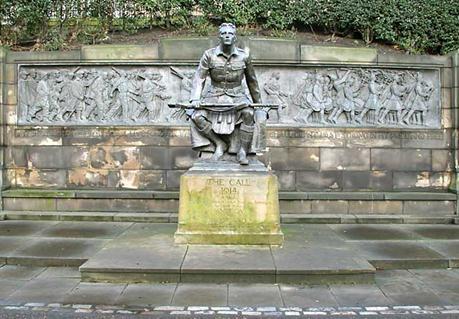 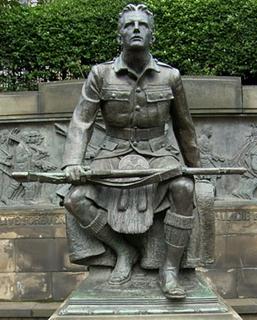
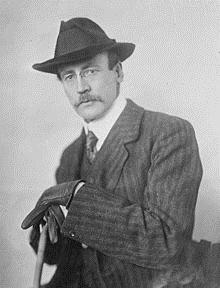 |
The Scots
American War Memorial or Scottish American War
Memorial in Princes Street Gardens in Edinburgh, called
"The Call 1914", was erected in 1927 and shows a kilted
infantryman looking towards Castle Rock. The bronze backdrop
frieze shows Scots of differing professions answering the
call and changing from civilians into marching soldiers
following a pipe band. The memorial was given by
Scottish-Americans to honor Scots who had served in the
First World War.
"The Call 1914" was
designed by R. Tait McKenzie (above), a Canadian-born
sculptor, doctor, soldier, physical educator, athlete and
Scouter working at the time at the University of
Pennsylvania in Philadelphia. McKenzie only took to
sculpture in later life having started his interests in
physical education. “The Call” took him four years to
complete. The memorial was
said to have cost ten thousand pounds at the time it was
built.
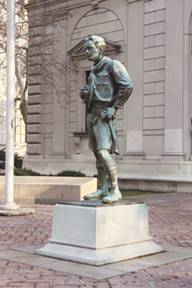 |
McKenzie’s most
famous sculpture is The Ideal Scout, also
known as The Boy Scout. This has been
reproduced and sits in front of many U.S. Boy
Scout offices across the nation, as well as at
the Philadelphia headquarters of the Boy Scouts
of America, and Gilwell Park, Australia. Others
include, Benjamin Franklin in 1723
(1910–14), University of Pennsylvania; The
Homecoming (1922), Cambridge, England;
The Victor (1925), Woodbury, New Jersey;
Edgar Fahs Smith (1925–26), University of
Pennsylvania; General James Wolfe (1927),
London, England, and; Jane Delano Monument
(1933), Washington, D.C. |
|
Near the end of
his life, McKenzie expressed a wish that following his death his
heart be buried in front of the Scottish-American War Memorial that
he had created in Edinburgh, Scotland. When he died in Philadelphia,
Pennsylvania, this request was denied by the "corporation of that
city", but his heart was subsequently buried at the nearby St.
Cuthbert churchyard.
At the very top
of “The Call 1914” are the two intertwined escutcheons of America
and Scotland. At the bottom of the frieze are lines from E. A.
Mackintosh's poem "A Creed": "If it be life that waits I shall
live forever unconquered; if death I shall die at last strong in my
pride and free."
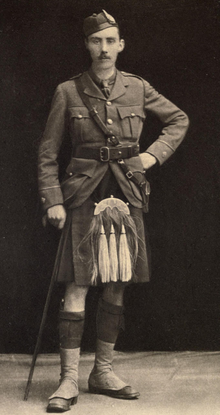 |
Lieutenant
Ewart Alan Mackintosh MC (4 March 1893 – 23 November
1917) was a war poet and an officer in the Seaforth
Highlanders from December 1914. Mackintosh was killed
whilst observing the second day of the second Battle of
Cambrai, 21 November 1917.
Ewart Alan
Mackintosh was born on 4 March 1893, the only son of
Alexander Mackintosh and his wife. Although he was born
in Brighton in Sussex, his father's roots were from
Alness in Ross and Cromarty. His maternal grandfather
was the preacher James Guinness Rogers. He said that it
was because of his grandfather's friendship with British
Prime Minister, William Ewart Gladstone, that he was
given his first name.
He studied locally at Brighton College whilst also
studying Gaelic and learning to play the pipes during
the holidays. He
continued his studies at St Paul's school in London and
then studied classics at Christ Church, Oxford.
Mackintosh, who was a member of the University of Oxford
Officers' Training Corps, tried to join the army
immediately war broke out in August and while still in
his university course. He was rejected on the grounds of
his poor eyesight. He reapplied and was accepted by the
Seaforth Highlanders, and was commissioned as a second
lieutenant on 31 December 1914. He served with the 5th
(The Sutherland and Caithness Highland) Battalion,
Seaforth Highlanders (a Territorial Force unit), which
was part of 51st (Highland) Division.
On 16 May he led
a raid near Arras where several of his men were killed.
One of them, David Sutherland, inspired a poem "In
Memoriam". Mackintosh was now a temporary lieutenant
and he received the Military Cross on 24 June 1916. His
citation in the London Gazette reads:
2nd Lt. (temp. Lt.)
Ewart Alan Mackintosh, l/5th Bn., Sea. Highrs., T.F. For
conspicuous gallantry. He organized and led a successful
raid on the enemy's trenches with great skill and
courage. Several of the enemy were disposed of and a
strong point destroyed. He also brought back two wounded
men under heavy fire. |
Mackintosh had been trying to
bring Sutherland, who had lost a number of limbs, back to the
trenches. Sutherland died of his wounds and had to be left; he
has no known burial place. At the age of 23, Mackintosh regarded
himself as a father to his men, and they affectionately called
him "Tosh". Sutherland was a Scot, but many of Mackintosh's
other charges were from New Zealand. One of Mackintosh's final
poems, Cha Till Maccrimmein, appears to foretell his own
death.
He returned to England in
August 1915 after being wounded in High Wood on the Somme. He
was stationed near Cambridge for eight months during which time
he was training cadets and he became engaged to Sylvia Marsh who
was from a Quaker family.
Mackintosh was killed in action
on the second day of the Battle of Cambrai, 21 November 1917,
whilst with the 4th Seaforth Highlanders. He was there observing
the heavy action near the
village of Cantaing. Cambrai was noteworthy in using new tactics
including the first mass use of tanks. He was buried in the
Orival Wood Cemetery near Flesquières in northern France.
At the unveiling ceremonies on
7 September 1927, Alanson B Houghton, the US Ambassador to
Britain, said of the seated bronze infantryman gazing toward
Castle Rock:
"Today we commemorate the
Great War with the figure of a common soldier – one youth
separated from the thronging files of recruits pressing on from
behind – one youth within sound of the pipes and drums and
within sight of the old Castle on the hill – one son of Scotland
from a mansion or a manse or a mine, from a farm or a factory,
from a Glasgow close or an Edinburgh lane – it matters not. For
he came from all of these. He kept lonely company with his own
soul in a tank or in a trench, on the sea or in the sky. And he
went to his death alone."
|





